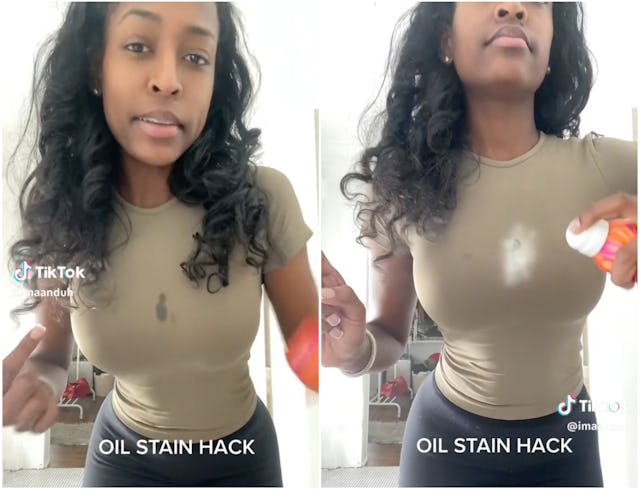TikTok Is Using Dry Shampoo To Remove Oil Stains From Clothes, But Does It Really Work?
Before you grab it from your purse, hear what the pros have to say.

TikTok life hacks are a dime a dozen these days, and some are certainly more useful than others. One viral hack making the rounds recommends using dry shampoo as an in-a-pinch method for instantly cleaning oil stains on your clothes, potentially saving your best shirts from salad dressing or cooking oil gone awry until you can safely get them into a washing machine.
And while the tip seems pretty handy — especially if you're in a restaurant and your kiddo accidentally flings some food on you — does this actually work? Could it damage the fabric or create an even worse stain? A professional cleaner and a laundry care expert break it all down… pun absolutely intended.
Why dry shampoo?
"Dry shampoo has become a popular hair care product for many people who want to quickly and easily refresh their hair without the need for a full wash," says Tide Scientist Darenton Randall. "It works by absorbing excess oil on the surface of the hair, leaving it looking and feeling cleaner."
As the many viral TikTok videos show, it can work in a pinch on a fresh, new oil stain. But don't expect it to work miracles; it's definitely not going to be as effective as a product designed to remove stains, like laundry detergent, says Marla Mock, President of Molly Maid, a Neighborly Company.
Noting that it's "not an optimal solution," Randall adds, "Dry shampoo is designed to work on the surface of the hair rather than fabrics, as it does not contain the necessary surfactants (aka cleansing agents) to break down and remove oil from deep within the fibers." So, you can give it a whirl as long as you follow up with a cold-water rinse using a high-quality detergent, he says.
Proceed with Caution
Before you reach into your bag to grab your trusty travel-size dry shampoo, you'll want to take some precautionary measures to protect the integrity of your garment, both pros note.
"The effectiveness of dry shampoo can vary depending on the fabric," says Mock. It may work better on synthetic fabrics, which are less prone to oil absorption. Natural fibers like cotton or linen tend to be more absorbent, making it harder for dry shampoo to remove oil stains completely. To be on the safe side, it's always a good idea to test the dry shampoo on a small hidden area of the fabric before treating the entire stain."
And it won't become your new go-to stain remover, says Randall. "When oil encounters fabric, it can seep deep into the fibers of a garment." He explains that synthetic fibers are especially hydrophobic, which means they do not like water. The oil-absorbing properties of dry shampoo aren't meant to break down deep stains and will likely only absorb the oil on the surface of the fabric, he says.
"Using dry shampoo on clothes may leave behind a residue," adds Mock. "Dry shampoos often contain starch or powders, which can result in a white or powdery residue on the fabric. This residue might be more noticeable on darker or colored fabrics. To avoid this, we recommend thoroughly brushing off the dry shampoo after applying it and then laundering the item as soon as possible to remove any remaining residue."
Also, you'll want to aim for a clear or translucent dry shampoo, as tinted ones could leave an even worse stain, says Mock. "It's important to check the ingredients list and avoid dry shampoos that contain harsh chemicals or ingredients that could potentially damage the fabric."
Randall offers a quick (ahem) refresher on how to properly treat an oil stain once you're back near your laundry machines:
- Using a plastic bucket, create a soak solution by adding 1/2 dose (approx. 25 ml) of detergent per gallon of water.
- Allow the garment to soak for up to 30 minutes. For an added benefit, add a white towel to the bucket to help keep the stained garment submerged in the solution.
There you have it. Sure, this hack works in a pinch — but it won't eradicate oil from the deep fibers of fabric, and you could make things worse if you're not careful. A proper wash remains your best bet against oil stains.
This article was originally published on